DNA-PKcs has KU-dependent function in rRNA processing and haematopoiesis
- PMID: 32103174
- PMCID: PMC10919329
- DOI: 10.1038/s41586-020-2041-2
DNA-PKcs has KU-dependent function in rRNA processing and haematopoiesis
Abstract
The DNA-dependent protein kinase (DNA-PK), which comprises the KU heterodimer and a catalytic subunit (DNA-PKcs), is a classical non-homologous end-joining (cNHEJ) factor1. KU binds to DNA ends, initiates cNHEJ, and recruits and activates DNA-PKcs. KU also binds to RNA, but the relevance of this interaction in mammals is unclear. Here we use mouse models to show that DNA-PK has an unexpected role in the biogenesis of ribosomal RNA (rRNA) and in haematopoiesis. The expression of kinase-dead DNA-PKcs abrogates cNHEJ2. However, most mice that both expressed kinase-dead DNA-PKcs and lacked the tumour suppressor TP53 developed myeloid disease, whereas all other previously characterized mice deficient in both cNHEJ and TP53 expression succumbed to pro-B cell lymphoma3. DNA-PK autophosphorylates DNA-PKcs, which is its best characterized substrate. Blocking the phosphorylation of DNA-PKcs at the T2609 cluster, but not the S2056 cluster, led to KU-dependent defects in 18S rRNA processing, compromised global protein synthesis in haematopoietic cells and caused bone marrow failure in mice. KU drives the assembly of DNA-PKcs on a wide range of cellular RNAs, including the U3 small nucleolar RNA, which is essential for processing of 18S rRNA4. U3 activates purified DNA-PK and triggers phosphorylation of DNA-PKcs at T2609. DNA-PK, but not other cNHEJ factors, resides in nucleoli in an rRNA-dependent manner and is co-purified with the small subunit processome. Together our data show that DNA-PK has RNA-dependent, cNHEJ-independent functions during ribosome biogenesis that require the kinase activity of DNA-PKcs and its phosphorylation at the T2609 cluster.
Conflict of interest statement
Figures


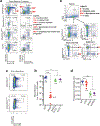
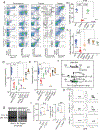

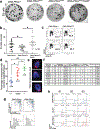


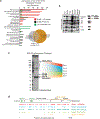
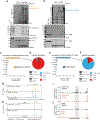
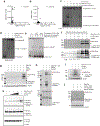
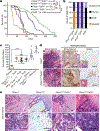



Comment in
-
DNA-repair enzyme turns to translation.Nature. 2020 Mar;579(7798):198-199. doi: 10.1038/d41586-020-00424-7. Nature. 2020. PMID: 32152600 No abstract available.
Similar articles
-
DNA-PKcs phosphorylation at the T2609 cluster alters the repair pathway choice during immunoglobulin class switch recombination.Proc Natl Acad Sci U S A. 2020 Sep 15;117(37):22953-22961. doi: 10.1073/pnas.2007455117. Epub 2020 Aug 31. Proc Natl Acad Sci U S A. 2020. PMID: 32868446 Free PMC article.
-
Phosphorylation at S2053 in Murine (S2056 in Human) DNA-PKcs Is Dispensable for Lymphocyte Development and Class Switch Recombination.J Immunol. 2019 Jul 1;203(1):178-187. doi: 10.4049/jimmunol.1801657. Epub 2019 May 17. J Immunol. 2019. PMID: 31101667 Free PMC article.
-
An Intrinsically Disordered APLF Links Ku, DNA-PKcs, and XRCC4-DNA Ligase IV in an Extended Flexible Non-homologous End Joining Complex.J Biol Chem. 2016 Dec 30;291(53):26987-27006. doi: 10.1074/jbc.M116.751867. Epub 2016 Nov 14. J Biol Chem. 2016. PMID: 27875301 Free PMC article.
-
Multicomponent assemblies in DNA-double-strand break repair by NHEJ.Curr Opin Struct Biol. 2019 Apr;55:154-160. doi: 10.1016/j.sbi.2019.03.026. Epub 2019 May 21. Curr Opin Struct Biol. 2019. PMID: 31125797 Review.
-
DNA-dependent protein kinase in telomere maintenance and protection.Cell Mol Biol Lett. 2020 Jan 17;25:2. doi: 10.1186/s11658-020-0199-0. eCollection 2020. Cell Mol Biol Lett. 2020. PMID: 31988640 Free PMC article. Review.
Cited by
-
The recent advances in non-homologous end-joining through the lens of lymphocyte development.DNA Repair (Amst). 2020 Oct;94:102874. doi: 10.1016/j.dnarep.2020.102874. Epub 2020 Jun 25. DNA Repair (Amst). 2020. PMID: 32623318 Free PMC article. Review.
-
The DNA repair protein DNA-PKcs modulates synaptic plasticity via PSD-95 phosphorylation and stability.EMBO Rep. 2024 Aug;25(8):3707-3737. doi: 10.1038/s44319-024-00198-3. Epub 2024 Jul 31. EMBO Rep. 2024. PMID: 39085642 Free PMC article.
-
Structural insights into the role of DNA-PK as a master regulator in NHEJ.Genome Instab Dis. 2021;2(4):195-210. doi: 10.1007/s42764-021-00047-w. Epub 2021 Jul 23. Genome Instab Dis. 2021. PMID: 34723130 Free PMC article. Review.
-
Nucleolus activity-dependent recruitment and biomolecular condensation by pH sensing.Mol Cell. 2023 Dec 7;83(23):4413-4423.e10. doi: 10.1016/j.molcel.2023.10.031. Epub 2023 Nov 17. Mol Cell. 2023. PMID: 37979585 Free PMC article.
-
Exploiting the DNA Damage Response for Prostate Cancer Therapy.Cancers (Basel). 2023 Dec 23;16(1):83. doi: 10.3390/cancers16010083. Cancers (Basel). 2023. PMID: 38201511 Free PMC article. Review.
References
-
- Zhu C et al. Unrepaired DNA breaks in p53-deficient cells lead to oncogenic gene amplification subsequent to translocations. Cell 109, 811–821 (2002). - PubMed
MeSH terms
Substances
Grants and funding
LinkOut - more resources
Full Text Sources
Other Literature Sources
Medical
Molecular Biology Databases
Research Materials
Miscellaneous

